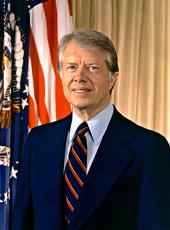
United States Competition in World Markets Message to the Congress Transmitting a Study.
To the Congress of the United States:
In accordance with the requirements of Section 1110(b) of the Trade Agreements Act of 1979, I hereby submit to the Congress a study of the factors bearing on the competitiveness of U.S. producers and the policies required to strengthen their relative competitive position in world markets. This study is submitted in conjunction with a report reviewing Executive Branch export promotion activities and potential programmatic and regulatory disincentives to exports, as called for in Section 1110(a) of the Trade Agreements Act. The greater part of the present study was prepared by the staff of the Department of Labor under the guidance of the Trade Policy Staff Committee, chaired by the Office of the United States Trade Representative. Contributions to this study were also made by several other agencies.
The study outlines the broad dimensions of various aspects of the competitiveness of U.S. producers in world markets. It also delineates our competitive position relative to our various competitors on a sectoral basis. Finally, the study directs attention toward the most important general areas for economic and trade policy formulation to strengthen our export competitiveness.
The study finds that during the past two decades there was an erosion in U.S. competitiveness in foreign and domestic markets. The increased international competition facing U.S. producers is in large part the result of increasing supplies of human and capital resources and expanding technological capabilities. Because of higher rates of growth in investment and expanded research activities in other countries, their competitive positions improved, and the United States experienced a relative decline in its trade performance even though the value of U.S. exports increased substantially, particularly in recent years. That decline has not affected all products, nor has it continued steadily. However, there remains much room for improvement in our competitive position through improvements in productivity.
Problems in our international competitiveness have combined with rapid increases in the cost of oil imports to create persistent merchandise trade deficits.
Despite the reduced U.S. role in world trade and our trade deficits, the United States remains the world's largest exporter. Approximately one dollar out of every five dollars worth of goods produced in the United States is now exported. Further, the United States continues to be competitive with other countries in a wide range of products. Record trade surpluses were recorded in our strongest export sectors in 1979: $18 billion in agriculture and $33 billion in industrial capital equipment.
The evidence presented in the study suggests the following three areas where policies should be considered to improve the competitive position of U.S. producers in world markets:
I. Expanded investment and innovation to enhance the productive capacity of the U.S. economy and raise the productivity of the labor force;
2. Strengthened programs to assist workers in adjusting their skills to shifts in the sectoral structure of the U.S. economy brought about by changes in trade;
3. New policies and programs to implement the Toyko Round agreements liberalizing access for U.S. exports and, further, identification of the significant remaining barriers to U.S. exports in certain sectors and negotiation to eliminate them.
I believe that export expansion is critical to the health of our economy. The policy emphasis that I have given to increasing exports has been demonstrated in three areas:
1. The National Export Policy that I announced on September 26, 1978;
2. The successful completion of the Tokyo Round of Trade Negotiations and signing of the Trade Agreement Act of 1979; and
3. The reorganization of the trade functions of the Executive Branch carried out earlier this year.
The National Export Policy articulated this Administration's intention to expand exports by increasing direct assistance to U.S. exporters, reducing domestic barriers to exports, and reducing foreign obstacles to our exports. The Tokyo Round agreements allow our exporters to take advantage of greater access to markets overseas through the liberalization of foreign nontariff restrictions and the reduction of for. eign tariffs. The Executive Branch trade reorganization centralizes U.S. trade policy functions in the Office of the United States Trade Representative and places trade administration and export promotion functions in the Department of Commerce. This reorganization has greatly enhanced the ability of the Federal government to implement policies for meeting the competitive trade challenges of the 1980's.
This study is the most comprehensive and detailed analysis of the competitive position of the United States in world markets ever undertaken by the U.S. Government. Its findings will be of immediate assistance to me and, I believe, to the Congress as we consider both broad economic policies and special measures to encourage more vigorous gains in our industrial productivity and to improve our international competitive position. I expect to address these matters extensively in the months ahead.
JIMMY CARTER
The White House,
September 9, 1980.
Note: The study is entitled "Study of U.S. Competitiveness—Study of Export Trade Policy as Mandated in Section 1110 of the Trade Agreements Act of 1979."
Jimmy Carter, United States Competition in World Markets Message to the Congress Transmitting a Study. Online by Gerhard Peters and John T. Woolley, The American Presidency Project https://www.presidency.ucsb.edu/node/250825
